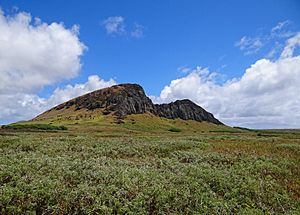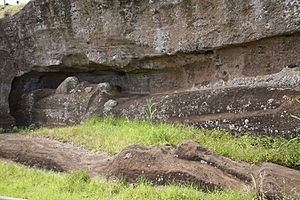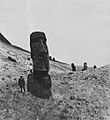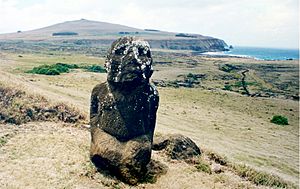Rano Raraku facts for kids

Rano Raraku is a special volcanic crater on Easter Island in Chile. It's made from a type of volcanic rock called tuff. For about 500 years, this place was like a giant factory! Most of the famous stone statues, called moai, were carved right here. About 95% of all the moai on the island came from Rano Raraku. It's like a giant outdoor museum, showing how the moai were made. You can still see 887 moai here today! Rano Raraku is part of the Rapa Nui National Park, which is a World Heritage Site.
Contents
What is Rano Raraku Like?
The sides of the Rano Raraku crater are very tall and steep. But on the north and northwest sides, they are much lower and slope gently. Inside the crater, there's a freshwater lake. This lake is surrounded by tall reeds called nga'atu or totora.
For a long time, people thought these plants might have come from South America. But now we know they have been growing on Easter Island for at least 30,000 years! The ancient Rapa Nui people used these reeds to build shelters and even as swimming aids.
Unfinished Moai in the Quarry
Many moai were left unfinished in the quarry. It's amazing to see how many there are! Some are high up on the crater wall, in places that seem hard to reach. The biggest unfinished moai is huge, about 21.6 meters (71 feet) tall. That's almost twice as tall as any completed moai! It would have weighed around 270 tonnes, which is super heavy.
Some moai were left unfinished because the carvers hit very hard rock inside the tuff. Other statues might have been meant to stay connected to the rock forever. They were never supposed to be moved.
Moai Standing Outside the Quarry
Outside the quarry, you can see many moai standing up. Some of them are buried up to their shoulders in the dirt from the quarry. These moai are special because their eyes were not carved out. They also don't have the red stone hats called pukao. Unlike many other moai on the island, these ones were not knocked down during the island's past conflicts. Because of this, they are some of the most famous images of Easter Island.
Tukuturi: The Kneeling Moai
One very unique moai is called Tukuturi. It stands out because it has a beard and is kneeling. Most other moai are standing tall and don't have beards.
This kneeling pose is well-known on Easter Island and is called tuku turi or tuku. It was a common posture for men and women who sang in special festivals called riu. Singers would often lean back slightly, raise their heads, and have a goatee, just like the Tukuturi statue.
Tukuturi is made from red rock called scoria, which comes from a place called Puna Pau. But it sits here at Rano Raraku, the tuff quarry. Some experts think Tukuturi might be connected to the Tangata manu (Birdman) cult. If so, it could be one of the very last moai ever created. It seems likely that this statue represents a riu singer and was made after the classic moai statues stopped being produced.
See also
 In Spanish: Rano Raraku para niños
In Spanish: Rano Raraku para niños









